Typical growth hacker stories focus on “how” someone achieves an amazing outcome – how Twitter got users to come back, how Dropbox used referrals to drive customer acquisition. But what we don’t hear so much about is the crucial step before the flashy “hack” occurs. It’s in this interim, before the execution of the thing, where growth hackers exhibit a much less talked about skill — goal-setting.
Behind every growth hack is a goal ow.ly/HQS9I 
Yesterday, we teamed up with Sean Ellis and Morgan Brown of Growthhackers.com to explore why goals are so effective, the ways they can go wrong, and how to use them like a growth hacker.
If you missed it, you can download the slide deck or watch the full event here:
Goals are for learning
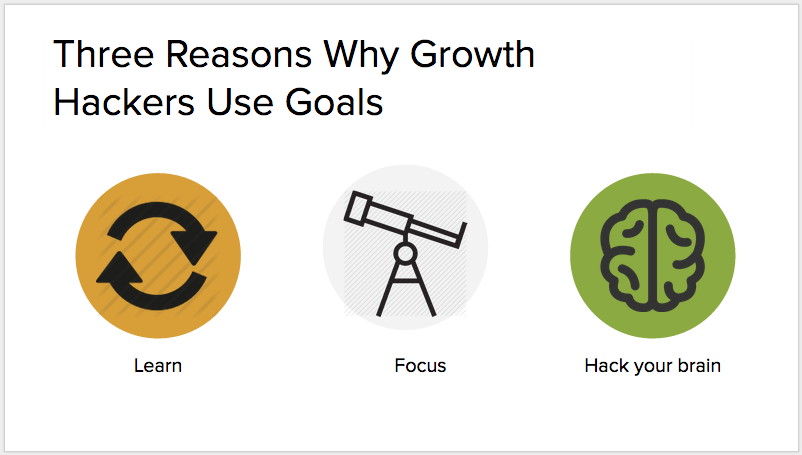
Growth hackers use goals to focus their efforts, and they’re extremely good at leveraging the powerful psychological benefits of goal-setting to hack their own brains. But the main reason growth hackers love goals is because goals drive tremendous amounts of learning. Growth hackers treat each goal not as an intimidating make-or-break ultimatum, but as a hypothesis:

For example, if your goal is to “get 50 new customers”, your hypothesis might be something like this:
“If we have a webinar, we will generate 50 new customers, because I think we can generate 1,000 new leads and maintain a 5% lead to customer conversion rate.”
If you hit that goal, amazing! You now know that doing more webinars would be a great use of your time. But if you don’t hit your goal you have a starting place to learn: Are webinars the wrong format (variable)? Did overestimate how many leads you would get (result)? Or was the problem with your ability to convert those leads into customers (rationale)?
When you’re in the stage of figuring out how your business works — this information is gold.
Reasons goals go wrong
Some of the most common pitfalls in the goal-setting process include getting too close to one end of the goal-setting spectrum (fuzzy, undefined goals) or the other (goal-driven-to-the-extreme). In the former example, you miss out on the psychological benefits that come from setting goals. In the latter example, you set yourself up for negative results, potentially dangerous, results — as in the case of the exploding Ford Pinto.

A few of the other big reasons our presenters touched on were:
Setting too many goals
Setting a bunch of goals with the idea that merely having them will generate motivation is known as “false hope syndrome”. This is a surefire way to lose focus.
"Goals are harder to achieve than we think." Setting too many goals can lead to False Hope Syndrome #GHgoals
— MilSpouseBizInc (@MilSpouseBizInc) January 22, 2015
Setting goals that are impossible
This one is especially relevant to leaders. Not hitting a goal is demoralizing in any environment, but on a team of high-achievers it can be devastating. You want to build a culture of success, so creating short feedback loops and lots of achievable steps along the way is key.
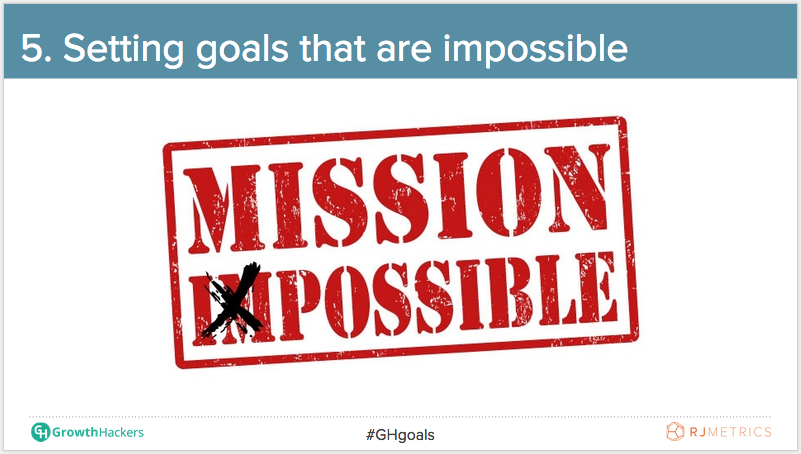
Measuring success with vanity metrics
The secret to steering clear of dreaded vanity metrics is to define failure just as clearly as you define success. It’s tough for people to define failure, so you’ll really have to push for this. Deciding on both success and failure criteria at the time you set your goal will prevent you from letting an effort linger too long before you iterate.
RT @RJMetrics: "Define failure just as clearly as you define success" @robertjmoore #GHgoals
— Janessa Lantz (@janessalantz) January 22, 2015
How to use goals like a growth hacker
The best way to avoid these common goal-setting mistakes is to remember that goals are most effective when used to drive learning. Here’s a framework on how this looks:
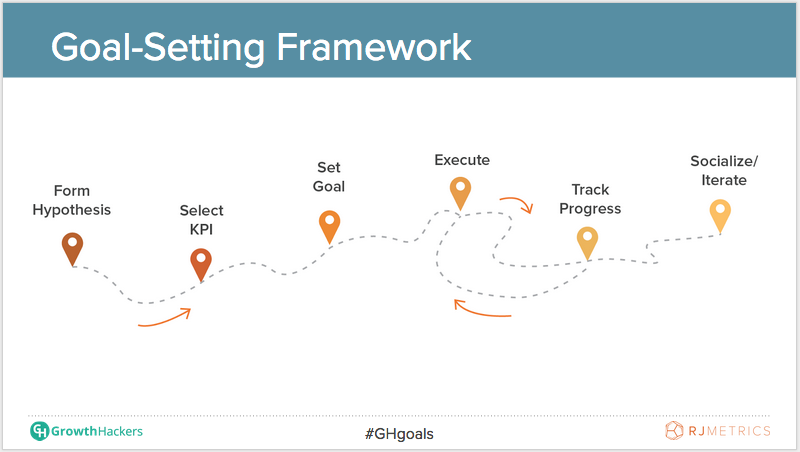
This approach lacks the structure of the traditional, “goals-are-set-in-stone” approach. Instead, emphasis is placed on the entire process of goal-setting, instead of just the goal itself.
Execute and track progress
In this framework, short feedback created by regularly tracking progress and adjusting execution, have a multiplying effect on all the reasons that goals are so effective.
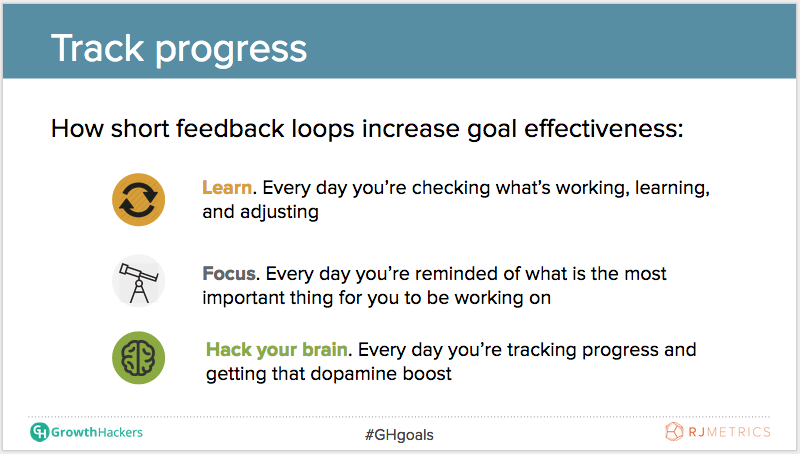
Not only will tracking your progress daily give you a dopamine boost, but it will keep you focused and constantly learning. You can incorporate goals into your workflow through tools like excel spreadsheets or GA reports. Anything that quickly and easily keeps your progress front-and-center will work.
Socialize your goals
Keeping your team aligned around goals, and making a point to share both successes and failures, reinforces focus while keeping everyone on track toward the ultimate goal — to learn. Common ways to do this include things like weekly emails, internal dashboards, large displays in the office, and regular meetings.
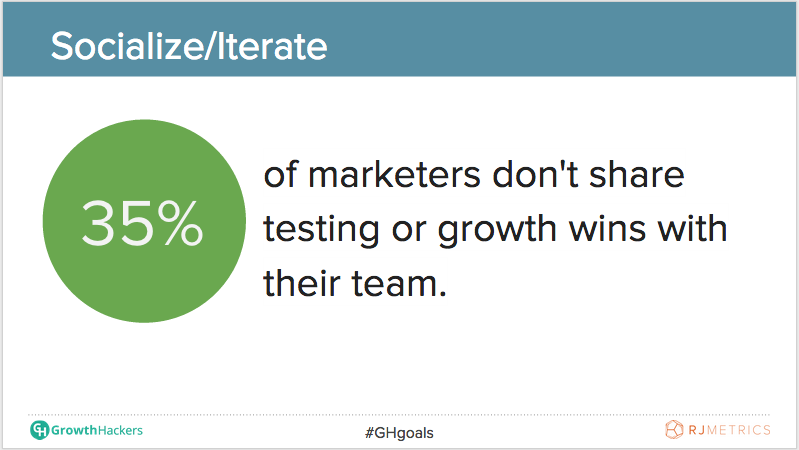
To keep team motivated and them to contribute It is important to communicate whatever is the goal you set and the results achieved #GHgoals
— Andrea Moro (@andrea_moro) January 22, 2015
Keep on Learning about Goals
Our presenters covered a ton information during this webinar. If you want to continue exploring the research and resources they mentioned, here are the links:
- Still have questions? Add them to the goals thread on growthhackers.com. Sean Ellis, and other members of the team, are standing by to weigh in.
- The basketball/gorilla study about how too narrow a focus can cause “inattentional blindness”
- The MIT study on how dopamine helps us stay focused on long-term goals
- The Harvard Business School paper on how a goal-driven-to-the-extreme approach can go terribly wrong”
- Edwin A. Locke’s research showing that 90% of laboratory and field studies involving specific and challenging goals resulted in higher performance than did easy or no goals
- And finally, because we got so many questions about it, here’s the story of the RJMetrics gonginator!
Thanks to everyone who joined us, and congratulations to Abdul Umer, who participated in the Twitter hashtag contest (#GHgoals) and won a dozen cupcakes.
Yeah!! Winning is definitely it's own #DopamineRush. Thanks! #GHgoals
— Abdul Umer (@KanyesBoy) January 22, 2015

(photo credit to Monica Watson, past cupcake winner)

